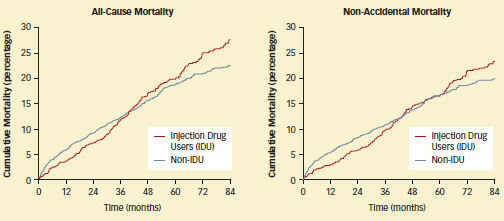Limited access, financial constraints, and stigma—rather than lifestyle—may be the main obstacles keeping HIV-infected injection drug users from obtaining the benefit of highly active antiretroviral therapy (HAART). In a prospective study in a setting of universally guaranteed health care, including free medications for the indigent, mortality rates from HIV in infected people who used illicit injection drugs and those who did not use injection drugs were nearly identical over the 5 years following HAART initiation.
In 2006, 205,000 injection drug users were living with HIV in the United States, according to the Centers for Disease Control and Prevention. Although HAART is not a cure, it improves the prognosis for people infected with the virus. However, past studies have shown that physicians tend not to recommend HAART when a patient has a history of injection drug use. Some doctors assume that injection drug users will be unable to adhere to HAART's stringent medication regimens or that liver disease, which is common among injection drug users, might impede the medications' therapeutic efficacy. The new results counter those concerns and indicate that access to HAART can improve the health of HIV-infected patients who have a history of injection drug use.
Monitoring Patient Mortality
In their study, Dr. Evan Wood of the British Columbia Center for Excellence in HIV/AIDS and colleagues enrolled everyone who started HAART therapy in British Columbia, Canada, between August 1996 and June 2006. Of these 3,116 men and women, 915 used injection drugs. At the time they initiated anti-HIV therapy, both the injection drug users and the other patients averaged about 40 years of age and, as citizens of Canada, had access to free medical care and HAART.
 Injection Drug Users Benefit from HAART: In British Columbia, where everyone has full access to HIV care and medications, injection drug users' all-cause and HIV-related survival rates did not differ from those of other patients throughout 7 years following initiation of highly active antiretroviral therapy (HAART).
Injection Drug Users Benefit from HAART: In British Columbia, where everyone has full access to HIV care and medications, injection drug users' all-cause and HIV-related survival rates did not differ from those of other patients throughout 7 years following initiation of highly active antiretroviral therapy (HAART).Dr. Wood and colleagues followed the participants until June 30, 2007—a span of 5.3 years on average for the patients who used injection drugs and 4.3 years for the other patients. During the first year on HAART, 41 percent of the patients using injection drugs took 95 percent or more of their medications on schedule, as compared with 63 percent of the other patients. Nevertheless, the two groups' cumulative mortality rates, 27 percent and 22 percent, respectively, did not differ meaningfully at any point. These rates yielded an estimate that the drug injectors' risk of dying was 1.09 times that of the other patients—a difference well within the range that is potentially attributable to chance. The relative risk estimate narrowed further, to 1.06, when the researchers excluded from their analysis 87 deaths—caused by accidental poisonings, suicides, and trauma (see graph)—that were clearly unrelated to the HIV disease process. Although the two groups' mortality rates appeared to be diverging at the end of the followup period, the data demonstrated a clear clinical benefit of making HAART available to patients who use injection drugs.
"Potent antiretroviral therapies equally benefited people with and without injection drug use, despite the lower medication adherence among people who had used injection drugs," says Dr. Wood. "HAART not only benefits the health of individuals, but it may also reduce the transmission of HIV to others." The team plans to examine whether, by lowering viral load, HAART can decrease the number of new transmissions from both injection drug users and people who do not inject drugs.
"Approximately one-third of HIV infections outside sub-Saharan Africa are attributable to injection drug use, according to the Joint United Nations Programme on HIV/AIDS," says Dr. Jacques Normand, director of NIDA's AIDS Research Program. "Because HAART has produced dramatic improvements in HIV patients' survival and may reduce transmission of the virus, increasing HAART delivery to injection drug users should be a global public health priority."
Source
Wood, E. et al. Highly active antiretroviral therapy and survival in HIV-infected injection drug users. JAMA 300(5):550-554, 2008. [Full Text]
